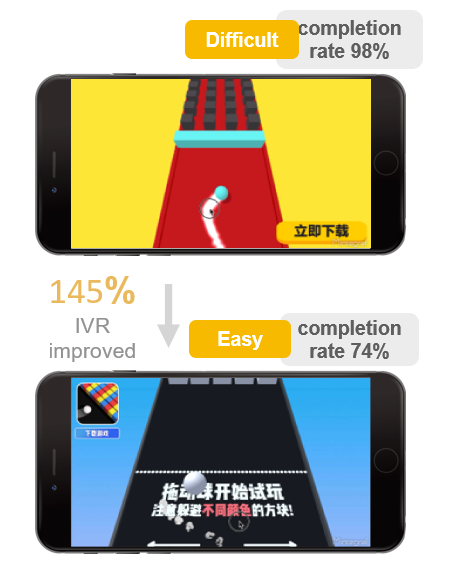Creative Strategies to Get UA Right for Your Hyper-Casual Games
Over the last two years, we’ve seen hyper-casual games growing from a handful of niche apps to a dominant force in mobile gaming. From just a couple of studios to tens or even hundreds in 2019, the industry has seen a significant shift, both in terms of users and resources. What do industry experts say about hyper-casual games, this new genre that has taken the mobile industry by storm?
Strong ad creatives can tell a good story
With the hyper-casual market growing at such a fast pace, it’s only a matter of time before the market gradually matures. More studios are developing hyper-casual games than ever before, so making your voice heard in this space is becoming increasingly challenging. So what are your options?
Because ad-based monetization is key for their survival, hyper-casual games have to rely on strong ad creatives for user acquisition. And since a defining feature for these games is their simplicity and ease of playing, how you communicate that can make all the difference. In other words, your creatives need to tell a good story and they need to answer one crucial user question: “why should I play your game?”
Creative strategy analysis: 3 key things to do first
Before you start working on designing ad creatives, you need to focus on 3 main areas. This will ensure you get the most out of your creatives.
1. Find out what your game’s main selling points are
If your game is similar to various other games on the market, you should look for differentiating factors. Maybe the core gameplay is unique, or maybe art style is what sets your game apart – then focus on those elements instead and make sure they stand out in your creatives.
2. Analyze your target audience
You probably have a certain target group when creating a game, but you need to dig a little deeper. Find out more about things like cultural or regional preferences and use these findings by blending them into the creatives to create customized material.
3. Be consistent
When it comes to distribution channels, in an era dominated by video content, it’s important to keep in mind that each channel has its strengths and weaknesses, so stay consistent with the channel you’re targeting. Another aspect to pay attention to is consistency between ad creative and the game itself. Remember: if the content presented in the ad creative does not match the game itself, the user experience will be negative and conversion rates will suffer as a result.
Use psychology to your advantage
There are 3 factors to consider when making the right ad creative: content, presentation, and psychology. You’ve got your content because it’s based on your game, you’ve got the presentation because you figured out your distribution channels, but what about the psychological element?
While technology tends to go on a never-ending evolution trend, human needs and desires tend to stay the same. This is where psychology comes into play: by using certain “hooks”, you can get your ad creatives to outperform the competition.
Cognitive Closure: Your brain is wired to get answers and solve problems as quickly as possible. Therefore, for ad creatives, you need to make it clear and easy to follow – explaining gameplay in a few clear steps will help users understand how to achieve the goal – that’s a prime example of helping the brain solve a problem quickly.
Opinion Leader: It’s widely known just how important Key Opinion Leaders (KOLs) are online. Using a KOL in your creatives (visually or as audio commentary) to showcase the game and teach users how to play it, is surprisingly effective. This is because people tend to listen to the expert opinion of someone who might be an early adopter in a field or influencer in certain groups.
Earworm Effect: There are two vectors that can affect your ad creatives: visual and auditory. When it comes to audio, try using catchy pieces of music that can stay with your target audience’s long after seeing/hearing the ad. In terms of video, synchronizing video imagery with audio rhythms can also have a significant positive impact, so try pairing these two vectors.
Herd Effect: This has been proven to work in marketing since we tend to believe something that has been previously approved by others. If other people use a certain product, then it must be good (“if an app is on the top 10 charts then it’s gotta be good!”). This is why you can use user ratings or reviews, as selling points on creatives. Also, the herd effect includes another powerful motivator: the fear of missing out; if others are enjoying this game, I have to give it a try!
Creative tips for playable ads
According to Mindworks, playable ads tend to perform better than regular video ads. In fact, playable ads CTRs tend to be twice as high and IVRs are around 3 times higher. Not only that, but there are several customizable elements that can help you tweak playable ads for maximum ROI – let’s have a look.
1. Clear guidance: Simplify your gameplay, give users tips if they’re stuck, make sure the demo goal is obvious to your users.

Source: Mindworks presentation @ Hyper-casual Games in East and West Seminar,
ChinaJoy 2019
2. Multi-step outcome: Your creative should aim to accomplish 3 main things: it should have a clear goal, your demo should have a proper tempo, and the user should receive positive visual/audio feedback for completing the level.

Source: Mindworks presentation @ Hyper-casual Games in East and West Seminar,
ChinaJoy 2019
3. Enhance user feedback: make sure the user’s actions are clear, using strong visual or sound effects so that they get instant feedback on their gameplay.

Source: Mindworks presentation @ Hyper-casual Games in East and West Seminar,
ChinaJoy 2019
4. A/B testing visuals: test different themes or skins, difficulty, BGM, etc., then analyze the results and iterate based on elements like audience segment/geographical area/seasonality.

Source: Mindworks presentation @ Hyper-casual Games in East and West Seminar,
ChinaJoy 2019
5. Custom CTAs: customized Call-To-Action buttons that talk about the core selling point of the game.

Source: Mindworks presentation @ Hyper-casual Games in East and West Seminar,
ChinaJoy 2019
6. Control the demo duration: Try to show as much of the game in as short a time as possible. The demo can’t be too long (data shows ideal duration is around 10-40s), so play around with the demo duration to find the sweet spot.

Source: Mindworks presentation @ Hyper-casual Games in East and West Seminar,
ChinaJoy 2019
7. Control the demo difficulty: look at game completion rates and adjust difficulty levels so that most users can get the full demo experience.

Source: Mindworks presentation @ Hyper-casual Games in East and West Seminar,
ChinaJoy 2019
Conclusion
The hyper-casual market is growing and with it, so are the challenges that publishers are facing. In an increasingly-homogenous market, it’s important to make sure your game stands out and this is where well-executed ad creatives can make all the difference.
By using psychology, proper user targeting and consistency between the ad creatives and the game itself, hyper-casual developers can take their UA campaigns to the next level and generate strong ROI. And remember: if you are going for playable ads (which the Mindworks team recommends using), take advantage of their customizability and use data to tweak them until you find the sweet spot.


